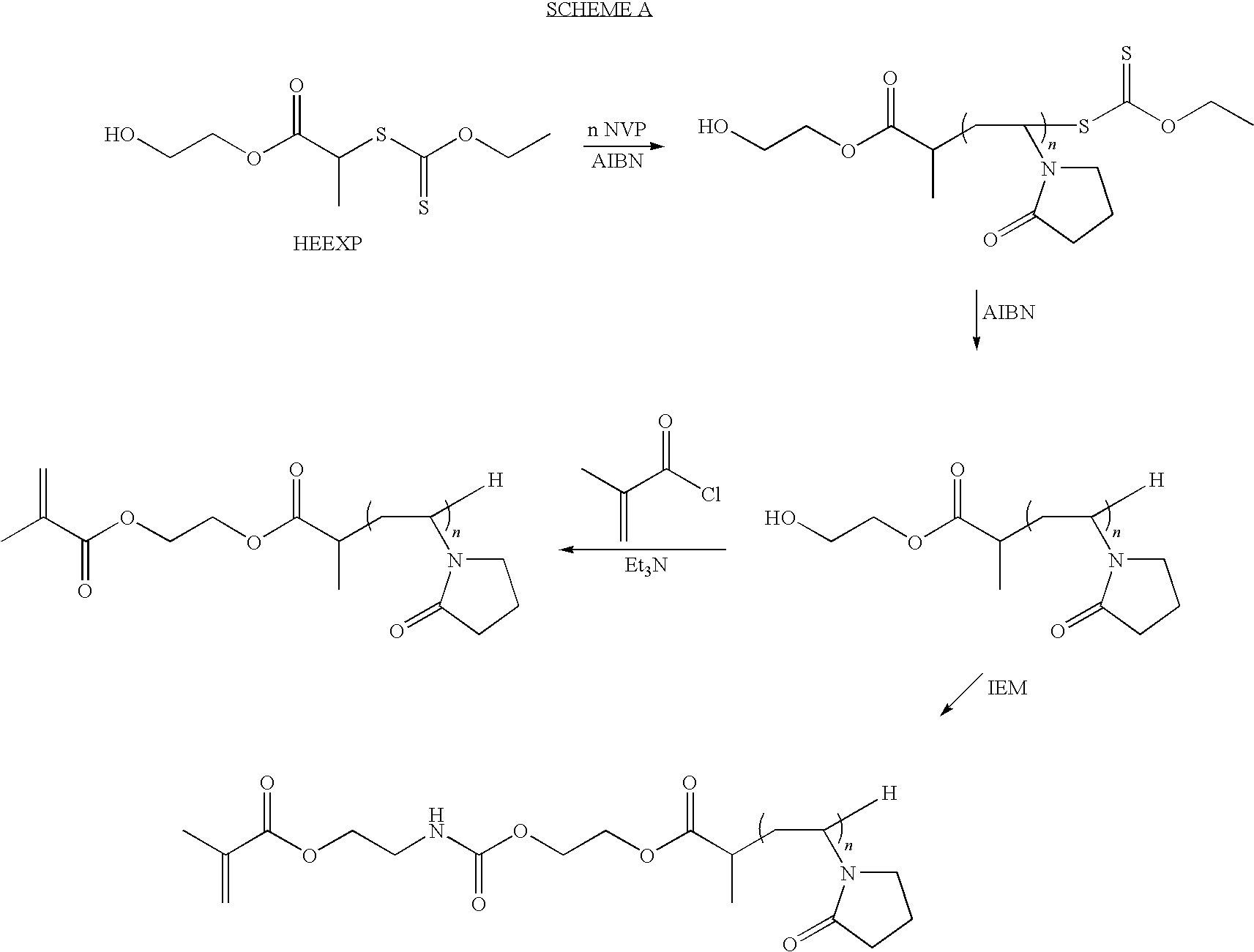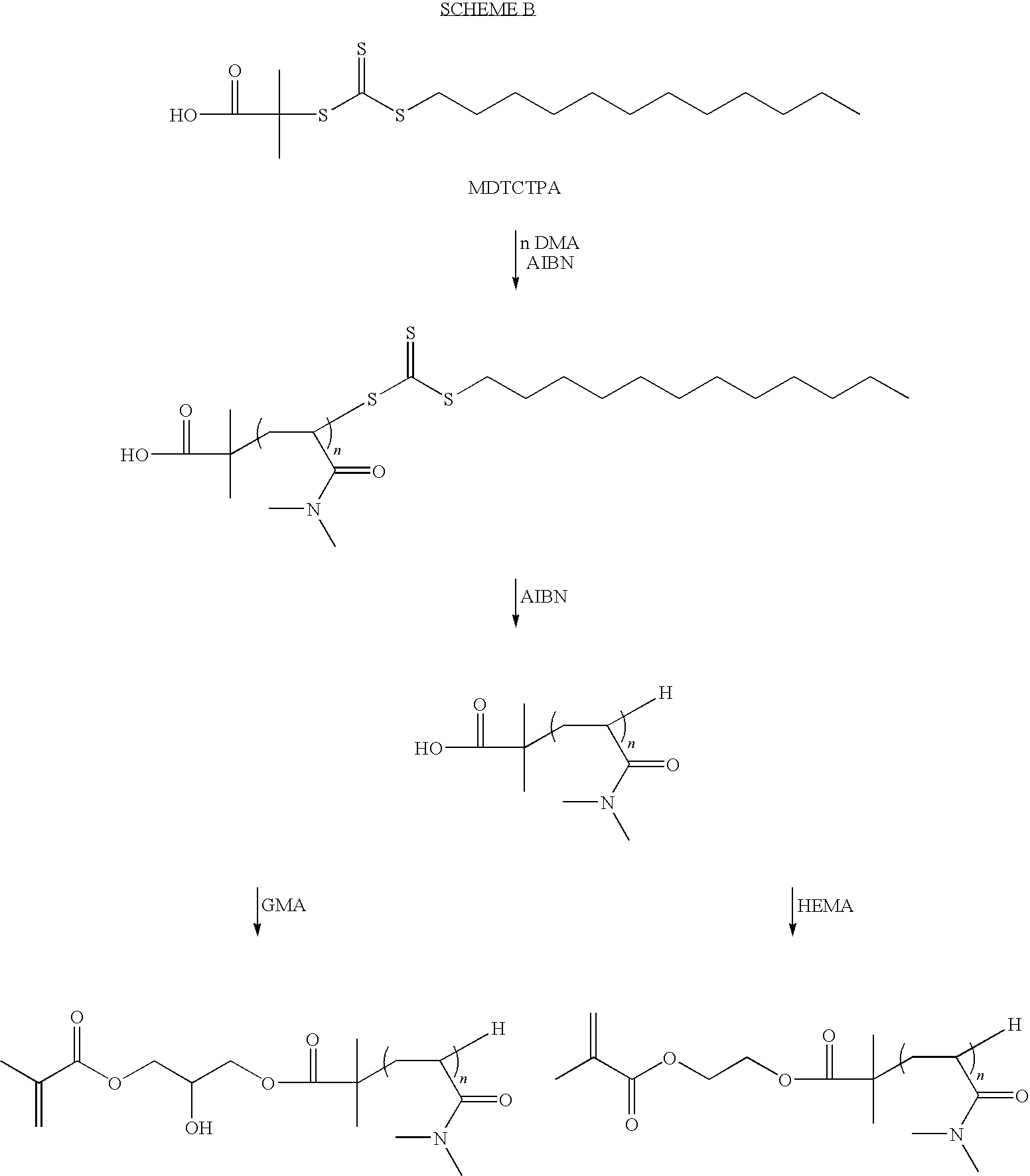Brush Copolymers
a technology of copolymer and brush, applied in the field of brush copolymer, can solve the problems of eye discomfort or even inflammation, surface of the lens affecting the susceptibility of the lens to deposition, and the process is disclosed, so as to prevent or limit the adsorption of tear lipids, improve the performance quality and/or comfort, and preserve the clarity of the contact lens
- Summary
- Abstract
- Description
- Claims
- Application Information
AI Technical Summary
Benefits of technology
Problems solved by technology
Method used
Image
Examples
example 1
Preparation of Methacrylated PVP Macromer
[0086]To a 1-L 3-neck round bottom flask containing a magnetic stir bar, water-cooled condenser and thermocouple was added 0.177 g AIBN (0.30-wt % based on total weight of NVP), 4.22 g (10-mol % based on NVP, Aldrich No. M2650) of 2-mercaptoethanol and 60 g of distilled NVP (Aldrich Cat. No. V3409). The mixture was dissolved by the addition of 250 mL of anhydrous THF to the flask. Next, the solution was sparged with argon for at least 10 minutes before gradual heating to 60° C. The sparging was discontinued when the solution reached 40 to 45° C. and the flask was subsequently maintained under argon backpressure. After 72 hours the heating was discontinued at which point the room temperature (RT) solution was opened to the atmosphere through a drying tube containing Drierite. Triethylamine (8.65 mL, 1.15 equivalents based on mercaptoethanol, Aldrich Cat. No. 471283) was added to the flask, whereupon some of the dissolved polymer precipitated. ...
example 2
Preparation of PVP Brush Polymer
[0087]To a 1-L 3-neck round bottom flask containing a magnetic stir bar, water-cooled condenser and thermocouple was added 0.152 g AIBN (0.40-wt % based on total weight of monomers), 1.21 g (4.25-mol %, Combi-Blocks No. BB-3222) of 3-methacrylamidophenylboronic acid, 25.0 g of the methacrylated PVP macromer of Example 1 (15 mol %), 2.01 g (8.5 mol %, Aldrich Cat. No. 409-472-1L) of deinhibited and distilled DMAPMA and 9.95 g (72.25-mol %, Aldrich Cat. No. 274135-500 mL) of distilled DMA. The mixture was dissolved by addition of 200-mL of methanol to the flask. The solution was sparged with argon for at least 10 minutes before gradual heating to 60° C. The sparging was discontinued when the solution reached 40 to 45° C. and the flask was subsequently maintained under argon backpressure. After 72 hours heating was discontinued at which point the cooled solution was added drop wise to 6 L of mechanically stirred ethyl ether. The precipitate was then isol...
example 3
Preparation of Methacrylated DMA Macromer
[0088]To a 1-L 3-neck round bottom flask containing a magnetic stir bar, water-cooled condenser and thermocouple was added 0.177 g AIBN (0.30-wt % based on total weight of DMA), 4.73 g (10-mol % based on DMA, Aldrich No. M2650) of 2-mercaptoethanol and 60 g of distilled DMA (Aldrich Cat. No. 274135). The mixture was dissolved by the addition of 250 mL of anhydrous THF to the flask. The solution was sparged with argon for at least 10 minutes before gradual heating to 60° C. The sparging was discontinued when the solution reached 40 to 45° C. and the flask was subsequently maintained under argon backpressure. After 72 hours heating was discontinued at which point the RT solution was opened to the atmosphere through a drying tube containing Drierite. Triethylamine (9.70 mL, 1.15 equivalents based on mercaptoethanol, Aldrich Cat. No. 471283) was added to the flask, whereupon some of the dissolved polymer precipitated. The solution was stirred at ...
PUM
| Property | Measurement | Unit |
|---|---|---|
| Molecular weight | aaaaa | aaaaa |
| Hydrophilicity | aaaaa | aaaaa |
Abstract
Description
Claims
Application Information
 Login to View More
Login to View More - R&D
- Intellectual Property
- Life Sciences
- Materials
- Tech Scout
- Unparalleled Data Quality
- Higher Quality Content
- 60% Fewer Hallucinations
Browse by: Latest US Patents, China's latest patents, Technical Efficacy Thesaurus, Application Domain, Technology Topic, Popular Technical Reports.
© 2025 PatSnap. All rights reserved.Legal|Privacy policy|Modern Slavery Act Transparency Statement|Sitemap|About US| Contact US: help@patsnap.com



